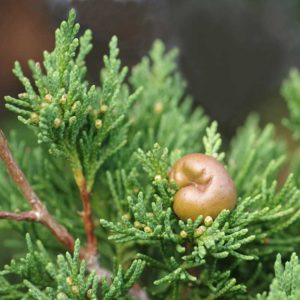Howdy, BugFans,
Plant galls are swellings formed on the outsides of flowers, buds, leaves, veins, petioles, stems and/or trunks. Many are stimulated by animals, but some are caused by fungi and bacteria, and technically, the thickened bark tissue where two leaning trees rub against each other is a gall (technically, a raised wart or calloused area on human skin could be called a gall, too). Galls precipitated by animals appear on specific parts of specific hosts and are formed in distinctive shapes, and the names of the host and the gall-maker are often intertwined. Mites and insects (especially aphids, flies, and wasps) are the usual culprits.
Here’s the short version: a mite or an immature insect (or perhaps its mother, when she deposits it there) introduces chemicals to a plant that signal it to grow extra tissue. The mechanics of feeding may contribute, too. The tissue surrounds the bug, enclosing it in an edible shelter. Galls are pretty predator-resistant, though some parasitoids have figured it out, and some animals eat the whole gall. Leafier galls invite co-habitation by inquilines (from the Latin for “lodger” or “tenant”) – tiny insects looking for a place to squat, and perhaps for a meal. The tissue that will feed the tiny larva or nymph is also a prison, protecting the plant from any further peregrinations.
Most galls are smallish and thick-walled, which doesn’t leave much room for the gall-maker; by default, gall insects and mites are tiny, and since they don’t move around a lot, the younger stages may dispense with unnecessary parts like legs (here’s a Scanning Electron Microscope image of a gall mite ). Some galls are woody and persistent and can still be seen on plants in the next growing season, but new galls start to appear early as female gall-makers or their offspring take advantage of the new vegetation.
In general, gall-makers don’t damage their hosts, but there are some cosmetic effects, and sometimes the weight of the galls makes trees more susceptible to weather damage. The Catch 22 of gall control is that by the time the galls are apparent, the gall-maker is tucked inside, out of reach of pesticides. In order to get rid of unsightly leaves, you have to lop off branches.
This is not our first foray into galls; to travel back to where it all began, see https://uwm.edu/field-station/galls-i/, https://uwm.edu/field-station/galls-ii/, https://uwm.edu/field-station/galls-iii-oddball-galls/.
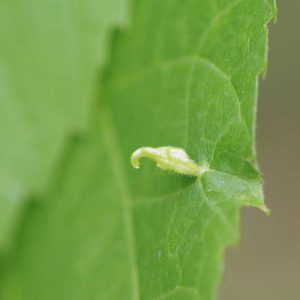 BASSWOOD SPINDLE/BUGLE/RED NAIL GALLS are caused by a mite named Eriophyes tiliae, family Eriophyidae (basswood’s genus is Tilia ). The female mite overwinters in bark crevices and emerges as warming air summons the new leaves. She feeds on the tender leaves, and the galls that form have an entrance/exit hole on the under surface of the leaf . She will eventually mate within her gall, lay her eggs in it, and die. Her offspring mature in about two weeks and then leave the gall, dispersing on the wind or hitchhiking on other animals. Imagine the odds against a barely-mobile mite floating through the air and landing on the proper host plant!
BASSWOOD SPINDLE/BUGLE/RED NAIL GALLS are caused by a mite named Eriophyes tiliae, family Eriophyidae (basswood’s genus is Tilia ). The female mite overwinters in bark crevices and emerges as warming air summons the new leaves. She feeds on the tender leaves, and the galls that form have an entrance/exit hole on the under surface of the leaf . She will eventually mate within her gall, lay her eggs in it, and die. Her offspring mature in about two weeks and then leave the gall, dispersing on the wind or hitchhiking on other animals. Imagine the odds against a barely-mobile mite floating through the air and landing on the proper host plant!
If it does, and if the basswoods are still putting out new growth, there may be a second generation of galls; otherwise, the final generation will retire to bark shelters in fall. Some spindle galls are red . Various species of Eriophyes mites target basswood, willow, cherry, maple, and even poison ivy, each producing a designer chemical that makes the characteristic gall.
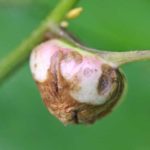 HICKORY POUCH/LEAF STEM GALLS are caused by an aphid called Phylloxera caryaecaulis, in the family Phylloxeridae (hickory trees are in the genus Carya and caulis means stem). The name Phylloxera raises a bunch of red flags because a related aphid is a huge pest in vineyards – some European grape varieties were almost wiped out by this American aphid in the 1800’s but were saved by grafting them onto resistant American varieties (with, said the connoisseurs, a resulting decline in quality).
HICKORY POUCH/LEAF STEM GALLS are caused by an aphid called Phylloxera caryaecaulis, in the family Phylloxeridae (hickory trees are in the genus Carya and caulis means stem). The name Phylloxera raises a bunch of red flags because a related aphid is a huge pest in vineyards – some European grape varieties were almost wiped out by this American aphid in the 1800’s but were saved by grafting them onto resistant American varieties (with, said the connoisseurs, a resulting decline in quality).
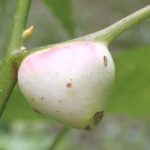 Anyway, the aphids overwinter as eggs, and a gall forms as a newly-emerged, wingless female feeds on the early leaves and petioles. Eventually, she lays eggs (remember, lots of aphids practice parthenogenesis during most of their life cycle – females give birth to more females, no males required). The nymphs, which will be winged, feed inside the gall for about two weeks , and then the gall splits, releasing them. They lay more eggs, and these produce both males and females (insuring that the gene pool doesn’t get stagnant), and their eggs will overwinter.
Anyway, the aphids overwinter as eggs, and a gall forms as a newly-emerged, wingless female feeds on the early leaves and petioles. Eventually, she lays eggs (remember, lots of aphids practice parthenogenesis during most of their life cycle – females give birth to more females, no males required). The nymphs, which will be winged, feed inside the gall for about two weeks , and then the gall splits, releasing them. They lay more eggs, and these produce both males and females (insuring that the gene pool doesn’t get stagnant), and their eggs will overwinter.
Hickory pouch galls start out green, take on a reddish tinge as they age, and turn black after they split. These galls are not as innocuous as the basswood spindle galls – if a tree is young or is heavily infested with Phylloxera for successive years, branches may be weakened.
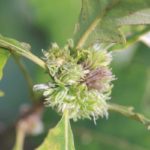 OAK ROSETTE GALLS are caused by a tiny wasp Andricus quercusfrondosus (Quercus is the genus of oak trees). Oaks host a lot of different galls, and many of them are formed by similar gall wasps/”gall flies” in the family Cynipidae. The BugLady has been trying to track this one down for years – she finally found it as Andricus frondosa in “Fifty Common Galls of the Chicago Area” — but she wasn’t able to find out very much about it. Oak rosette gall wasps use post, white, and bur oaks as hosts.
OAK ROSETTE GALLS are caused by a tiny wasp Andricus quercusfrondosus (Quercus is the genus of oak trees). Oaks host a lot of different galls, and many of them are formed by similar gall wasps/”gall flies” in the family Cynipidae. The BugLady has been trying to track this one down for years – she finally found it as Andricus frondosa in “Fifty Common Galls of the Chicago Area” — but she wasn’t able to find out very much about it. Oak rosette gall wasps use post, white, and bur oaks as hosts.
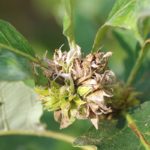 The gall-maker is a wasp larva that induces the plant to grow a dense cluster of small leaves, and it stays in the leafy gall throughout winter and exits in spring (along with its inquilines, which may include species of gall wasps that don’t make their own galls but find protection in others.’). Like aphids, some cynipid species are parthenogenic, and others alternate all-female generations with two-sex generations.
The gall-maker is a wasp larva that induces the plant to grow a dense cluster of small leaves, and it stays in the leafy gall throughout winter and exits in spring (along with its inquilines, which may include species of gall wasps that don’t make their own galls but find protection in others.’). Like aphids, some cynipid species are parthenogenic, and others alternate all-female generations with two-sex generations.
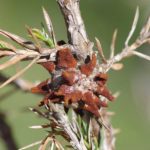 The CEDAR APPLE GALL (Gymnosporangium juniperi-virginianae) (Juniperus virginiana is the scientific name of eastern red cedar) is actually a rust; the gall is caused not by an arthropod but by a fungus, and it has an interesting life cycle. Finding the rust in its early stages is like finding a juniper dressed up in sea anemones.
The CEDAR APPLE GALL (Gymnosporangium juniperi-virginianae) (Juniperus virginiana is the scientific name of eastern red cedar) is actually a rust; the gall is caused not by an arthropod but by a fungus, and it has an interesting life cycle. Finding the rust in its early stages is like finding a juniper dressed up in sea anemones.
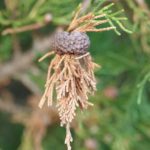 It’s in a family of rust fungi called Pucciniaceae (the BugLady wonders whether the person who named this family was an opera fan). It’s a common rust in North America, and it needs two kinds of host trees to complete its life cycle – a juniper species and an apple species (including hawthorn, serviceberry, and crabapple). The fungus overwinters on the red cedar.
It’s in a family of rust fungi called Pucciniaceae (the BugLady wonders whether the person who named this family was an opera fan). It’s a common rust in North America, and it needs two kinds of host trees to complete its life cycle – a juniper species and an apple species (including hawthorn, serviceberry, and crabapple). The fungus overwinters on the red cedar.
The orange-tentacled “anemone” appears with the spring rains, and the tentacles that produce spores (they’re called “gelatinous telial horns”) soon wither, but they’re capable of rehydrating a few times. Spores are blown to nearby apple trees, which get yellow spots on the upper surfaces of their leaves and eventually, bunches of tiny, spore-dispersing tubes or threads below (some pictures here ). The spores that are made on the apple trees are only able to grow if they land on a juniper, and the beat goes on. It may take two years after the return trip for the galls to form again on juniper.
Vocabulary word for the day – the study of the mechanics of galls and gall-makers is called cecidiology/cecidology, and the studier is called a cecidiologist/cecidologist.
Go outside – find some galls!
The BugLady
